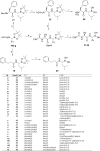Towards Selective Mycobacterial ClpP1P2 Inhibitors with Reduced Activity against the Human Proteasome
- PMID: 28193668
- PMCID: PMC5404560
- DOI: 10.1128/AAC.02307-16
Towards Selective Mycobacterial ClpP1P2 Inhibitors with Reduced Activity against the Human Proteasome
Abstract
Mycobacterium tuberculosis is responsible for the greatest number of deaths worldwide due to a bacterial agent. We recently identified bortezomib (Velcade; compound 1) as a promising antituberculosis (anti-TB) compound. We showed that compound 1 inhibits the mycobacterial caseinolytic proteases P1 and P2 (ClpP1P2) and exhibits bactericidal activity, and we established compound 1 and ClpP1P2 as an attractive lead/target couple. However, compound 1 is a human-proteasome inhibitor currently approved for cancer therapy and, as such, exhibits significant toxicity. Selective inhibition of the bacterial protease over the human proteasome is desirable in order to maintain antibacterial activity while reducing toxicity. We made use of structural data in order to design a series of dipeptidyl-boronate derivatives of compound 1. We tested these derivatives for whole-cell ClpP1P2 and human-proteasome inhibition as well as bacterial-growth inhibition and identified compounds that were up to 100-fold-less active against the human proteasome but that retained ClpP1P2 and mycobacterial-growth inhibition as well as bactericidal potency. The lead compound, compound 58, had low micromolar ClpP1P2 and anti-M. tuberculosis activity, good aqueous solubility, no cytochrome P450 liabilities, moderate plasma protein binding, and low toxicity in two human liver cell lines, and despite high clearance in microsomes, this compound was only moderately cleared when administered intravenously or orally to mice. Higher-dose oral pharmacokinetics indicated good dose linearity. Furthermore, compound 58 was inhibitory to only 11% of a panel of 62 proteases. Our work suggests that selectivity over the human proteasome can be achieved with a drug-like template while retaining potency against ClpP1P2 and, crucially, anti-M. tuberculosis activity.
Keywords: antimycobacterial; caseinolytic protease; dipeptidyl boronic acid.
Copyright © 2017 Moreira et al.
Figures










Similar articles
-
Bortezomib Warhead-Switch Confers Dual Activity against Mycobacterial Caseinolytic Protease and Proteasome and Selectivity against Human Proteasome.Front Microbiol. 2017 Apr 27;8:746. doi: 10.3389/fmicb.2017.00746. eCollection 2017. Front Microbiol. 2017. PMID: 28496439 Free PMC article.
-
Target mechanism-based whole-cell screening identifies bortezomib as an inhibitor of caseinolytic protease in mycobacteria.mBio. 2015 May 5;6(3):e00253-15. doi: 10.1128/mBio.00253-15. mBio. 2015. PMID: 25944857 Free PMC article.
-
Harnessing caseinolytic proteases ClpP1P2 for next-generation antimycobacterial agents: Mechanisms, challenges and opportunities.Eur J Med Chem. 2025 Oct 15;296:117858. doi: 10.1016/j.ejmech.2025.117858. Epub 2025 Jun 19. Eur J Med Chem. 2025. PMID: 40582187 Review.
-
Mycobacterial Caseinolytic Protease Gene Regulator ClgR Is a Substrate of Caseinolytic Protease.mSphere. 2017 Mar 15;2(2):e00338-16. doi: 10.1128/mSphere.00338-16. eCollection 2017 Mar-Apr. mSphere. 2017. PMID: 28317028 Free PMC article.
-
[Development of antituberculous drugs: current status and future prospects].Kekkaku. 2006 Dec;81(12):753-74. Kekkaku. 2006. PMID: 17240921 Review. Japanese.
Cited by
-
N-Pyrazinoyl Substituted Amino Acids as Potential Antimycobacterial Agents-The Synthesis and Biological Evaluation of Enantiomers.Molecules. 2020 Mar 27;25(7):1518. doi: 10.3390/molecules25071518. Molecules. 2020. PMID: 32230728 Free PMC article.
-
AAA+ Machines of Protein Destruction in Mycobacteria.Front Mol Biosci. 2017 Jul 19;4:49. doi: 10.3389/fmolb.2017.00049. eCollection 2017. Front Mol Biosci. 2017. PMID: 28770209 Free PMC article. Review.
-
BacPROTACs targeting Clp protease: a promising strategy for anti-mycobacterial drug discovery.Front Chem. 2024 Jan 31;12:1358539. doi: 10.3389/fchem.2024.1358539. eCollection 2024. Front Chem. 2024. PMID: 38357296 Free PMC article.
-
Structural Insights into Bortezomib-Induced Activation of the Caseinolytic Chaperone-Protease System in Mycobacterium tuberculosis.Nat Commun. 2025 Apr 11;16(1):3466. doi: 10.1038/s41467-025-58410-4. Nat Commun. 2025. PMID: 40216758 Free PMC article.
-
An allosteric switch regulates Mycobacterium tuberculosis ClpP1P2 protease function as established by cryo-EM and methyl-TROSY NMR.Proc Natl Acad Sci U S A. 2020 Mar 17;117(11):5895-5906. doi: 10.1073/pnas.1921630117. Epub 2020 Mar 2. Proc Natl Acad Sci U S A. 2020. PMID: 32123115 Free PMC article.
References
-
- WHO. 2016. Global tuberculosis report 2016. WHO, Geneva, Switzerland.
Publication types
MeSH terms
Substances
LinkOut - more resources
Full Text Sources
Other Literature Sources
Medical
Molecular Biology Databases
Research Materials

